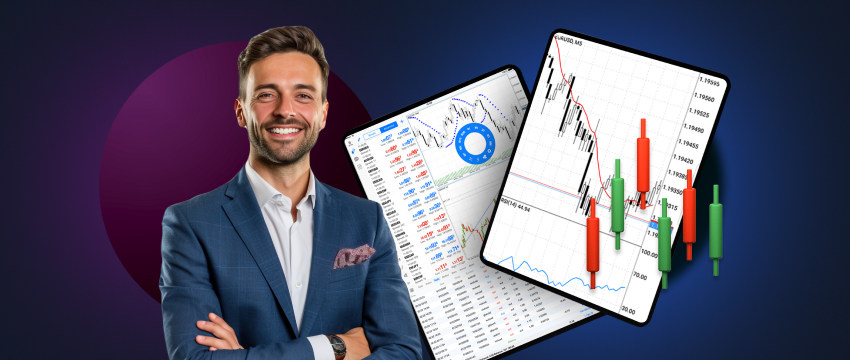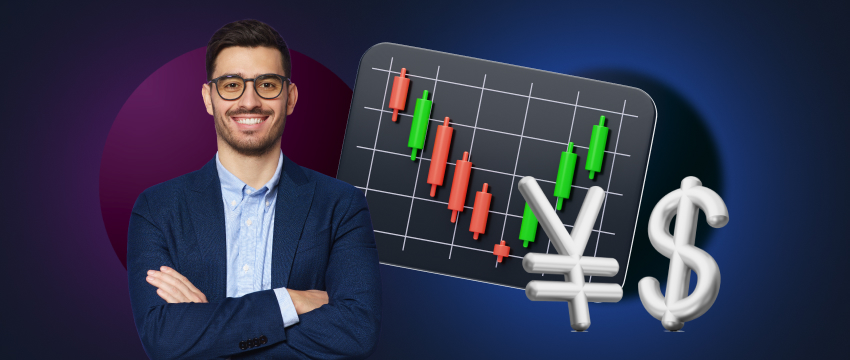The forex market is a highly volatile space. If trades are not properly managed, the risk of losing a lot of money increases exponentially. Even professional traders can fail if they become too complacent or don’t pursue continuous learning. This makes ongoing trading education key to maximising profits and mitigating losses.
What is a day trader?
A day trader is someone who executes short-term trades within minutes or hours in the course of a trading day. Some of the most popular forex trading strategies used by day traders include:
- Scalp trading. This is typically a short-term trading strategy whereby trades are held for seconds or minutes. Positions are usually closed before the end of the day. The premise is that smaller profits can be quickly accrued off frequent trades, building up to a larger cumulative return.
- Swing trading. Swing trading seeks to profit from short-term price movements (up and down) by attempting to identify the swings in advance.
- News-based (trending) trading. This style of trading monitors broader global events or economic news and then looks to identify trading opportunities from the volatility that these bring.

What type of trading education does a day trader need?
There are certain fundamentals a day trader must know in their attempt to make a profit from trading forex.
A good understanding of the way the forex market works
A daily trading volume of approximately US$6.6 trillion makes the forex market the largest (and most active) financial market worldwide. Open 24/5, it also has the highest liquidity out of any other market globally. Notably, trades transacted in the forex market impact economies all over the world. Some of the largest hubs for online forex trading include London, New York, Hong Kong, Sydney, Singapore, Tokyo and Frankfurt. Trading sessions are opened and exited based on the time zones of each jurisdiction.
Forex trades are also speculative. This means forex traders enter into Contracts for Difference (CFDs) on foreign currencies in anticipation that their value will rise and can be sold at a profit sometime in the future.
How currency pairs work in the forex market and the factors impacting currency prices
While there are 180 currencies in use worldwide, the USD$ continues to be the most commonly traded currency globally. This is followed by the euro (EUR). Other popular currencies are the British pound, the Japanese yen, the Australian dollar, the Canadian dollar, the Swiss franc and the New Zealand dollar. The most traded currency pairs in the world are called the majors and they are EUR/USD, USD/JPY, GBP/USD, AUD/USD, USD/CAD, USD/CHF and NZD/USD.
There are several ways in which currency prices can be impacted. This includes:
- General supply and demand
- Investor sentiment
- اسعار الفائدة
- Global political climate
- Rate of economic growth
- Central bank policies
- Natural disasters or environmental catastrophes

Working knowledge of technical analysis
Technical analysis is the study of historical price movements to potentially identify current price movements and trading conditions. It is based on the premise that the current market price reflects all market data. Technical analysts typically focus on technical indicators, chart patterns and historical data. They use a short-term approach, reviewing charts over the course of minutes, hours, or days.
Popular technical indicators
Day traders will use various technical indicators to optimise their trades. Five of the most popular include:
- The moving-average indicator is used to identify price trends in the market by levelling price data over a specific period by creating a continuous updated average price.
- Momentum indicators are used to measure the strength or weakness of stock prices over a specified period. They calculate the rate of change of prices rather than actual price changes.
- A type of momentum indicator, oscillators are used by traders when they cannot identify a clear trend in specific stock prices. Oscillators measure momentum, typically fluctuating between two bands (high and low), indicating whether an asset has been overbought or oversold.
- Support and resistance levels are used to establish a surplus of buyers (support) or a surplus of sellers (resistance) in the market. It is based on the concept of price movements due to supply and demand. In other words, when demand is high and supply low, prices rise. In contrast, when supply is higher than demand, prices fall.
- Volatility indicators measure volatility using historical data (price changes that have happened) and forecasting future price movements. Volatility indicators include Bollinger bands, Average true range, Keltner channel, Parabolic stop and reverse, and Volatility squeeze.
Learning resources to become a better day trader
With the increasing popularity of forex trading worldwide, access to an extensive scope of trading educational material online has become easy. This includes articles, blogs and eBooks from professional traders and leading forex brokers, explaining how forex trading works. YouTube videos on forex-related topics have also become a popular way for traders to broaden their knowledge. Research is key however to ensure you’re acquiring accurate information. Affordable webinars and online forex trading courses are also easily accessible, allowing you to grow your trading expertise, no matter where you are in the world.

Become a strategic day trader with T4 Trade
T4Trade is a leading online forex broker, popular among day traders worldwide due to its top quality 24/5 customer support, fast execution, flexible leverage and low spreads.
Consider opening a demo trading account with T4Trade to get a better feel for what trading through the broker will look like. The account will give you the chance to trade currency pairs in a risk-free environment, without using your own funds. The demo account usually mimics real market conditions, giving you vital insights into the intricacies of forex trading.
Opening a demo account is easy. Simply:
- Open a demo account.
- Start executing trades in a simulated trading environment using virtual money. Practice different trading techniques, and apply your trading strategies.
- Make use of an innovative pool of forex-related articles, tips, and tools. Learn the latest economic and geopolitical news for current insights.
Moving to a live trading account
Once you’ve gained sufficient expertise, consider moving to a live T4Trade trading account that suits your level of expertise, time available for trading and risk tolerance. Don’t forget that forex trading is highly volatile and the potential for incurring large losses is very high. Ensure you have effective risk management in place to mitigate the risk and navigate the complexities of forex trading more strategically.
Disclaimer: This material is for general informational & educational purposes only and should not be considered investment advice or an investment recommendation. T4Trade is not responsible for any data provided by third parties referenced or hyperlinked, in this communication.




